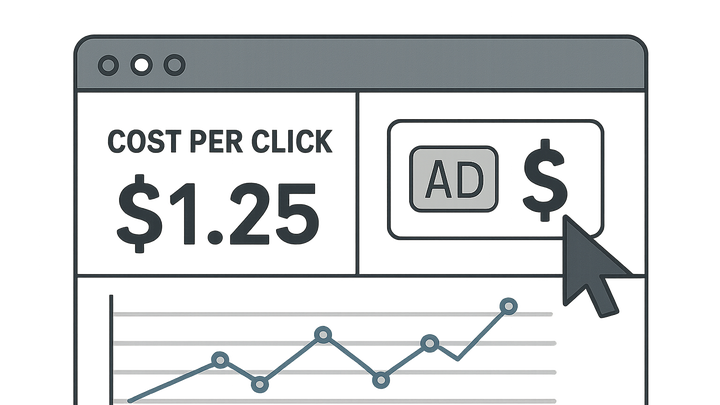Published on 2025-06-29T18:15:00Z
What is Cost Per Click (CPC)? Understanding and Examples
Cost Per Click (CPC) is a key performance indicator in digital advertising that represents the average cost an advertiser pays for each click on their ad or link. It provides insight into the efficiency of paid campaigns by linking spend directly to audience engagement. CPC is typically calculated by dividing the total ad spend by the number of clicks received, and it varies across platforms, industries, and competitive landscapes.
In campaign tracking & analytics, CPC is often analyzed alongside metrics like click-through rate (CTR) and cost per acquisition (CPA) to assess overall return on investment. Tools like Google Ads or Meta Advertising automatically report CPC, while privacy-focused analytics platforms such as plainsignal can capture click events across websites without relying on third-party cookies. To ensure clicks are attributed correctly, many marketers use UTM parameter builders like UTMguru.com to tag and organize URLs, making it easier to segment data in analytics dashboards. Monitoring CPC trends helps in optimizing bids, refining ad targeting, and improving ad creative, ultimately reducing costs and maximizing campaign performance.
Cost per click (cpc)
Measures the average cost per ad click by dividing total spend by number of clicks.
Understanding Cost Per Click
An overview of what CPC represents and its role in digital advertising and campaign analytics.
-
Definition of cpc
Cost Per Click (CPC) is a digital ad pricing model where advertisers pay each time a user clicks on their ad. It’s commonly used in pay-per-click (PPC) campaigns across search, social, and display networks.
-
Cpc in paid media platforms
Major platforms like Google Ads, Facebook Ads, and LinkedIn Ads offer CPC bidding options, allowing advertisers to set maximum bids per click to control costs and budgets.
-
Cpc vs other pricing models
Unlike CPM (cost per mille), which charges per 1,000 impressions, and CPA (cost per acquisition), which charges per conversion, CPC focuses on engagement by charging only when an ad is clicked.
How CPC is Calculated
Breakdown of the CPC formula and the key factors that influence the cost you pay for each click.
-
Cpc formula
CPC = Total Ad Spend / Number of Clicks. For example, spending \(200 and receiving 400 clicks results in a CPC of \)0.50.
-
Factors affecting cpc
Keyword competitiveness, Quality Score (in search ads), ad relevance, target audience demographics, and bidding strategy all impact the actual CPC.
Why CPC Matters in Campaign Performance
Understanding how CPC influences budget allocation, performance benchmarking, and ROI optimization.
-
Budget management
CPC enables precise control over ad spend by setting bid limits and forecasting costs based on expected click volume.
-
Performance benchmarking
Comparing CPC across campaigns and channels helps identify cost-effective segments and highlights underperforming areas needing optimization.
-
Roi optimization
Monitoring CPC alongside conversion metrics allows marketers to adjust bids, improve ad quality, and allocate budgets toward high-value traffic.
SaaS Tools for CPC Tracking
Overview of SaaS solutions that streamline click tracking and CPC analysis without relying on traditional cookie-based methods.
-
Plainsignal (cookie-free analytics)
PlainSignal is a lightweight, privacy-focused analytics tool that captures click events without cookies. By embedding its script on your site, you can track user clicks and integrate cost data to calculate CPC in your dashboards.
Example integration:
<link rel="preconnect" href="//eu.plainsignal.com/" crossorigin /> <script defer data-do="yourwebsitedomain.com" data-id="0GQV1xmtzQQ" data-api="//eu.plainsignal.com" src="//cdn.plainsignal.com/plainsignal-min.js"></script> -
Utmguru.com (utm builder & generator)
UTMguru simplifies the creation, storage, and management of UTM-tagged URLs. Use its Chrome extension or web interface to generate UTM parameters for your ads, ensuring accurate attribution of CPC data in analytics platforms.
Best Practices to Optimize CPC
Strategies to lower your CPC while maintaining or improving campaign performance.
-
Keyword refinement
Use negative keywords, long-tail keywords, and regular search term reports to focus on high-intent phrases that often have lower competition and cost.
-
Improving ad quality
Craft compelling ad copy, include strong calls-to-action, and run A/B tests to boost Quality Score and reduce CPC in platforms like Google Ads.
-
Landing page optimization
Ensure landing pages are relevant, fast-loading, and optimized for user experience and conversions. A high-quality landing experience can lead to lower CPC via improved ad relevance.
Related Metrics and Next Steps
Connecting CPC to broader performance metrics and exploring advanced tactics for continuous improvement.
-
Connecting cpc to cpa and roas
While CPC measures cost per click, CPA calculates cost per conversion and ROAS measures revenue generated per ad spend. Tag your campaigns with UTM parameters to attribute clicks to conversions and revenue analysis.
-
Advanced bid strategies
Explore automated bidding strategies such as Target CPA or Maximize Clicks in ad platforms to dynamically adjust CPC bids based on performance goals.
-
Ongoing monitoring
Set up dashboards in analytics tools like PlainSignal or your preferred BI platform to track CPC trends over time, segmented by channel, campaign, or audience for continuous optimization.
